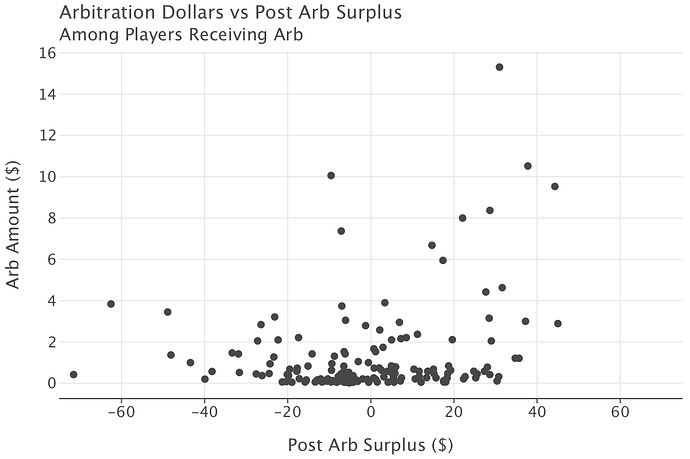Conclusions
Ottobasket managers seem to value youth and talent highly when assigning arbitration, a formula that I certainly can’t argue with too much. If there’s one player group that seems undervalued by the group, it’s the solid big men who are unlikely to make leaps into the upper echelons of the NBA and may not be even the second option for their team’s offense, but still produce consistently enough to be high value players.
I think it’s possible managers get too caught up in postseason hype, as exemplified in Tyrese Haliburton and Anthony Edwards getting arb’d past their regular season value. It’s harder to make this argument with Haliburton because he was on track to exceed his salary by quite a bit if he hadn’t gotten hurt, but injuries happen. They were both excellent in the postseason, showing their game can translate and leading their teams deep into the playoffs. Edwards in particular upped his game literally across the board with more points (at better efficiency), rebounds, assists, and stocks per game with only a small uptick in turnovers. But it also came in 40.6 minutes per game, an increase of 5.5 minutes over his regular season numbers and a number he’s basically a lock to not reach next season.
We see that most of the high-arb’d players still retained surplus value once it was assigned, and only Haliburton and Edwards received more than $4 of arb while being negative surplus post-arb. Ideally a few of the dots to the left of $0 post-arb surplus would shift down while those to the right shift up, but overall managers seem to be doing well. Although the post-arb surplus for players receiving arb was -$309, much of that was tied up in the players in the last table of the previous post. I don’t have numbers to support it, but I would guess it’s more common for a high salary player to end up with a very low value season - typically due to injury - than it is for a low salary player to break out to the extent they are +$50 or +$60 in surplus after arb.
Other Misses
In terms of players who weren’t arb’d while being surplus players, there weren’t many! Only 10.6% of post-arb surplus players - 9 in total - did not receive any arbitration, and they weren’t exactly a murderer’s row of players. Al Horford and Norm Powell were only +$0.72 after everything shook out, while Tre Jones and Caris Levert were +$3.47 and +$3.92, respectively. Paul Reed somewhat justified his preseason valuaton by performing well in Embiid’s absence and finishing +$6.01. He could remain a good value big depending on his role with the Pistons. Aaron Nesmith finished +$6.90 and with an average salary of only $4.44 - I suspect managers want to see him repeat his shooting performance and fill out the rest of his game before handing arb to him. Finally we end up with the three biggest misses - Bogdan Bogdanovic, Kelly Olynyk, and Dennis Schröder - who were all over $10 in surplus. They’re all on the older side, were on lottery teams, and two of them - Olynyk and Schröder - were traded midseason while Bogdanovic has consistently been in rumors. They’re also all international players about to play in the Olympics, which is a funny coincidence.
Out of this group, only Reed, Jones, and Nesmith are young, with all of them entering their age 25 season. I don’t really think Ottobasket managers erred not giving them arb.
Arb and Contending
This exercise has gotten me thinking about contending in Ottoneu. Many of the best teams at the end of the season are those who aggressively trade prospects and high surplus younger players for high priced stars (and the accompanying loans). For example, it seems many are willing to go up to $500 in salary for $450 in value if it means making the playoffs. This seems to go hand in hand with the idea to assign arb to talent over impact, so it is better to arb stars and either force cuts there or try to reduce the surplus from players in the $10-$30 range? Of course, this is only applicable when there isn’t an obvious arb candidate, but I think I would lean towards hitting the lower salary player who is more likely to get dealt during the season in exchange for a star. The stars tend to bunch on a few teams and therefore some of them have to get cut anyway as the team salary limit resets to $400 at the keep / cut deadline, putting them back in the auction pool while lower salary players are more likely to skate through. But that’s just my current thought!
Finishing Thoughts
Overall it seems like managers do a solid job of assigning arbitration money to players and without insight into every league’s context, it’s tough to fault any individual decision. After all, the LaMelo that got hit with arb could be the $59 one that is the lowest in Ottobasket - I would almost certainly keep a $59 LaMelo Ball! There are some tweaks that I would personally do, but every manager is trying to accomplish the same goal with different team-building philosophies.
As always, the best arb strategy is to simply have all 12 managers complete it. I’m looking forward to doing this again next year and perhaps getting some more longitudinal insight into the data!
